If you want to figure out how to move a city’s people around in a way that does not bow to dominant, auto-centric power structures and paradigms, you’ve got to have guts. It was with that in mind that Portland’s nationally renown transportation research center hosted the Fearless event at Portland State University last night.
Before I share a recap of all the intriguing ideas, a bit of housekeeping is in order. That aforementioned research center has been known since its inception in 2006 as the Oregon Transportation Research and Education Consortium, or OTREC. Last night they unveiled a new name. From now on they are simply TREC — the Transportation Research and Education Center.
TREC’s leader, Jennifer Dill, said dropping the “Oregon” from the name was done to reflect the “growth and natural evolution” of their work beyond regional borders.
Now, let’s learn more about the fearless ideas…
Event organizers chose 16 presenters from diverse professional backgrounds; everything from a bus advocate to an Intel engineer. In fact, the four highest vote-getters weren’t transportation-centric at all (I’ll come back to that later).
Each presenter was given three minutes and one slide to share their idea. Votes were taken and tallied immediately afterward.
PSU Professor Ethan Seltzer got things started by saying it’s time to end the standard practice of calling agencies “of transportation.” “Why do we have agencies that are called one thing when we are dealing with a world that is about anything but just one thing?” Getting beyond calling them “highway departments” was a big deal, but now, Seltzer said, “This about culture, not about stuff and it’s time to move on and adopt a different cultural perspective.”
Freelancer artist and designer (of Idaho Stop and CRC animation fame) Spencer Boomhower’s big idea is to promote a “Family Circuit” of multi-use paths that would become a big tourism draw and offer locals a quality opportunity for walking, biking, and exploring. The circuit would include the unbuilt Sullivan’s Gulch and the existing I-205, Springwater, and Esplanade paths. “It would take a lot of little ideas and turn it into one big idea,” he said, “and it would be a revenue generator.”
Nick Falbo, a senior planner at Alta Planning + Design, proposed that we should re-think gas stations. “They represent the most auto-oriented of land-uses yet they occupy some of our most walkable and dense districts.” Falbo wants to see the pumps placed curbside with other utilities and the mini-marts brought up to the edge of the sidewalk.
Bitch Media Online Editor and author Sarah Mirk might seem like a presenter out of left field, but many of you might recall her excellent transportation reporting while on the news staff of the Portland Mercury. Standing in front of a “Hot spot” map of fatal and serious injury collisions, Mirk said we should take the top ten most dangerous intersections and turn them into car-free zones every Sunday. “Have a block party at 82nd and Division, or how about a pet parade at Killingsworth and MLK?” she said. “Temporarily transforming the road can permanently transform our culture.”
Eugenio Arriaga, a graduate research assistant at PSU with a background at the vaunted Institute for Transportation and Development Policy (ITDP) in Guadalajara wants to make bike share more accessible to low-income and transit-starved neighborhoods. “How about serving those who need it the most, instead of individuals who already have a lot of transportation choices.” If we re-thought our bike sharing approach, Arriaga said, “Portland could become a true social innovator in an era of rising social inequality.”
Jerry Seinfeld — I mean, Chris DiStefano — who came out with a Seinfeld-esque, “Transportation planning, what’s the deal with that?! Am I right?” had a funny idea that would shame people who text and drive. The Rapha marketing and general bike industry insider said, “You get a ticket and we take you to the city limit. Just get out… no soup for you!”
How about we take transportation data gleaned from “smart” devices and use it to create fun and friendly competitions that encourage more walking, biking, and transit? That was the idea from PSU Professor Kelly Clifton.
Advertisement
Citizen Charlie Pye said Portland should stop using trucks to deliver freight in the city. Instead, he wants us to use autonomous vehicles in a network of underground tubes. This “Cargocap” was designed by a German university and they’ve even got working prototypes that have an estimated cost of just $5 million per mile. Think that’s crazy? “In the 19th century everyone ran raw sewage through city streets,” he reminded the audience, “If you told them to use underground tubes they would have thought you were crazy.”
Vivian Satterfield, a bus advocate with OPAL Environmental Justice, had a simple pitch: Make transit free. “Passe livre!” she shouted as she walked off stage.
The BTA’s Rob Sadowsky was one of three presenters with a Sunday Parkways-related idea. He said we should make the event bigger and better by creating a permanent route that runs on 17 miles of Burnside, then spurs to the north and south on major roads like 122nd, NW 23rd, Grand, and so on. “Sunday Parkways isn’t big and grand enough, let’s make it ciclovia-style!”
There were two Intel employees on last nights list of presenters. One of them was Brad Biddle whose side project, the Open Bike Initiative, is an intriguing alternative to standard bike share systems. Biddle’s big idea is to expand his concept and create an “open, ubiquitous network of bike sharing systems that are completely interoperable from a technical and business point-of-view.” “We should not be city number 551 in the world to implement a previous version of bike share,” he said, “We should be city number one implementing the next generation of bike share.”
Sam Seskin of CH2MHill brought two balloons on stage and urged everyone to simply “Break the bubble.” He wants transportation planners to get out of their comfort zone. “We can’t maintain the vision of our transportation needs if we’re ignoring other people’s points of view,” he said, “Our planning culture has become a civic religion… We’re a weird kind of cult.”
PSU PhD student Kristi Currans was another person who wanted more carfree experiences. Her idea? Carfree happy hours throughout the city ever day. She’d use automated bollards that would pop up at the appropriate time so that the streets could come alive with people instead of just cars. “Stop thinking of roadways as links to desinations, think of them as destinations themselves.”
Kevin Bross, an Intel engineer by day (he’s also on the Open Bike Initiative team), shared what seems like a very sensible idea — yet still a bit fearless: High-speed passenger ferry service on the Willamette River. He got the idea during a trip to Brisbane, Australia and said such a service could connect St. Johns to Oregon City (with stations on both sides of the river) at a fraction of the cost and with fewer political/public controversies that usually come with rail projects.
GlobeSherpa’s Nat Parker had a big idea once. He wanted to be able to purchase transit tickets with his smartphone. With that done, he know has a wonkier request. He was the standardized transit data feed that developers use to create cool apps to include ticketing information so that “Wherever you go you have one common experience and you don’t have to figure it out in each place.”
Steve Thorne, a professor of world languages and literature at PSU, thinks Portland needs more “flaneurie,” or, urban strolling and wandering. The way to do that, he said, is to bury Burnside so we can have a continuous parkway/plaza space from Waterfront Park to the North Park Blocks. His inspiration came after he and his kids were “nearly killed” when someone ran a red light on Burnside. “And my 82-year old mother just got knee replacement surgery,” he added, “So we should offer electric bicycle share too.”
When the votes were tallied, Brad Biddle’s “ubiquitous open source bike share” and Steve Thorne’s “bury Burnside” proposals tied for third. Second place went to Eugenio Arriaga’s vision for bike share and the winner was Kevin Bross and his “MetroCat” high speed passenger ferry service.
It’s interesting that all of the most popular ideas came from people who are not directly involved in transportation planning. Will any of them see the light of day? That depends on how fearless Portland leaders want to be.
What are your favorites? Or, do you have a big idea of your own you wish you could have shared?


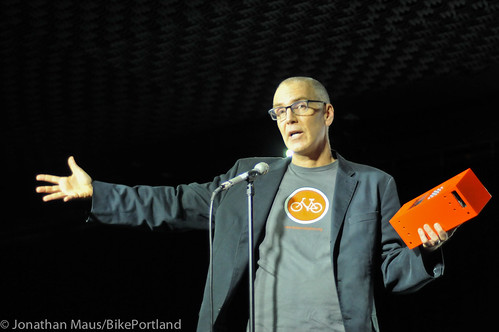
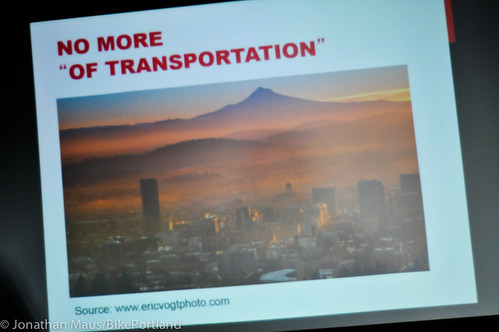
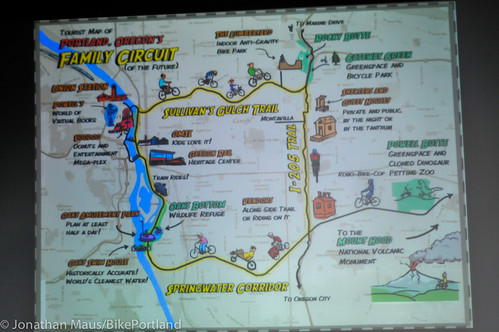

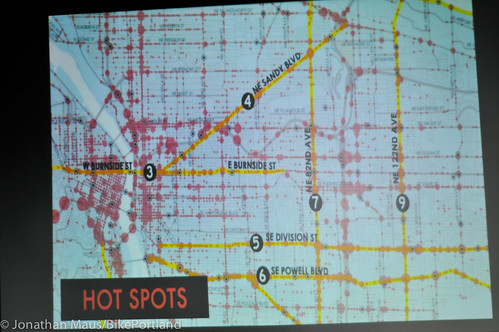


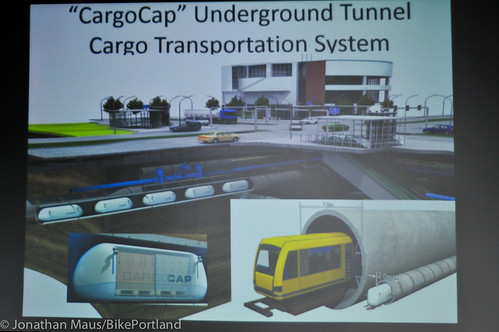
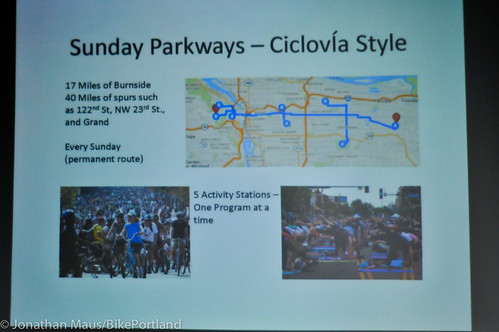

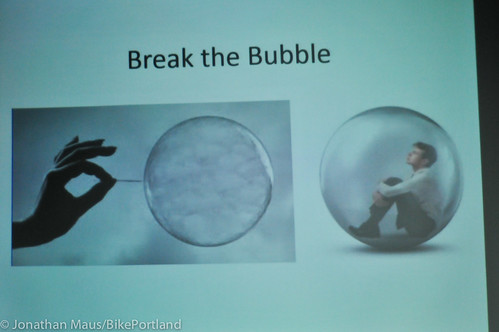
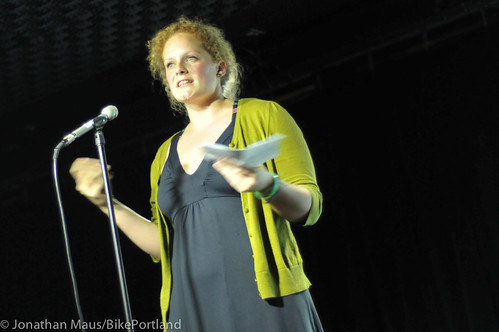
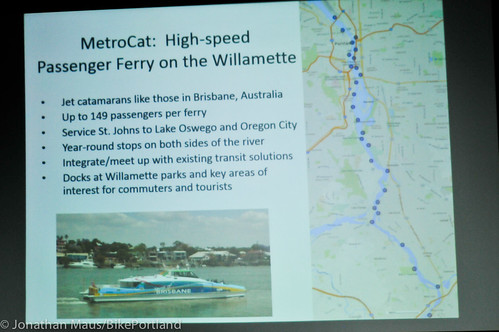





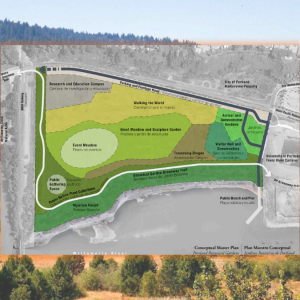
Thanks for reading.
BikePortland has served this community with independent community journalism since 2005. We rely on subscriptions from readers like you to survive. Your financial support is vital in keeping this valuable resource alive and well.
Please subscribe today to strengthen and expand our work.
I think Sarah Mirk’s idea is the best of the bunch. Sure, closing those intersections would be an inconvenience, but at least those inconvenienced would still be alive, right?
Ferry-oriented development!
Such fun and great ideas…
…as for Nick Falbo’s suggestion of moving vehicle liquid refuelling activity out to the curb side…this is the “old school” way as it was before the 1920s filling station and is in use is many parts of the world. One can still see it in rural or old urban areas of Northern Europe (typ. France).

That one is a terrible idea, imagine the pipe lines, tanks and leakage throughout the city with gasoline available like that. Though gas stations are hazards all unto themselves, at least the damage is centralized, and can be handled with in an effective (though expensive) manor.
That’s not to mention the car crashes into them, or if Portland should ever get the big earthquake they’ve been predicting.
Another variation on this idea would be to move the gas pumps to the back side of the service station and move the convenience store out to the sidewalk to maintain the pedestrian-friendly nature of the gas station. Cars would go into a driveway to the back of the lot and come out of a driveway, similar to some hotel parking garages.
This design would allow greater walk-in traffic to the C-store while still allowing for multiple lanes of refueling, left/right-side service, etc. It would also leave room for cars to queue up for pumps, something that the curbside pumps do not offer.
With proper ventilation design, you could even build offices/apartments above such a gas station design.
Bury Burnside? Yeah, ask Boston and Seattle how good of an idea that would be. Ugh.
Been to Boston lately? that area is really nice now. I know the project was beset with problems (corruption, faulty construction, lengthy delays, etc.) but those are all process issues and I’m by no means defending any of that. that said, the area has been transformed for the better.
Putting cars out of sight only hides the problem, it doesn’t slove it,
Capping 405 would be cheaper and equally effective. Cap 405!
And bury I-5 while we’re at it.
Cap I-405 and rename it I-5.
At the same time, remove I-5 from the central eastside and blow up the Marquam Bridge.
This!
Right! Except rename 205 as I-5
“…blow up the Marquam Bridge.”
You could sell tickets to that show.
I’d buy a ticket to see that!
Agreed. We should be capping/burying freeways first. Burnside can be fixed much more cheaply with a road diet.
Thanks for covering this event, Jonathan. “Passe Livre” is the term I used last night, from Brazil’s tarifa zero free fare movement.
Man oh man I’ve been hoping for a water ferry or taxi system in Portland for years! Infrastructure costs would be minimal, but still nothing to sneeze at. Imagine a “Park and Float” parking structure in Oregon City or St. Johns. People using the river like a real marina town. And of course bike racks on the boats. What a transformation for this city that would be!
The City of Portland did a feasibility study for ferry service a few years ago. They found the operating costs would require a per-passenger subsidy 2x-4x higher than bus and light rail. The study concluded it was not a good idea because the cost premiums were so high. I guess if money were not a constraint though, it’d be a good idea.
What if people payed extra for it as an express service?
How much would tickets need to be with no extra subsidy?
If we exclude capital costs for the moment, I expect that the service would cost ~$9 million to operate for a year (~$250/boat/service hour, 16 hours service per day [6am to 10pm], 6 boats average in service [7-8 boats at peak hours]). With 6 boats, I estimate there would be a ferry about every 30 minutes, while the 8 boats at peak service could run about every 20 minutes.
Divide the $9M by the number of riders to get the unsubsidized cost per year at that service level.
Even if it was 100% subsidized, the $9M/year operating costs are a fraction of the $208M projected to build the ill-fated Portland-to-Lake Oswego streetcar line (let alone buy the rolling stock and operate the line).
However, federal grant money may not be available to operate a ferry the way it is for building rail systems, even if that would save money in the long run. If the Oregon congressional delegation could get ferries access to some of these same pools of money that might otherwise be spent on rail capital projects (by getting rail and ferry classified similarly), that could change the game.
Nelson\Nygaard did a ferry feasibility study in 2006 which is still instructive (although a lot has changed since then). Operating costs are a little high and subsidy per trip is also high, but not insurmountable. Again, I am sure the demand, costs, and funding options need to be revisited.
http://www.portlandoregon.gov/bps/article/292730
Great pointer, thanks!
There’s some wacky ideas there, but my favorite is free transit. Ideally completely free, but I’d settle for a system that distributes annual passes to anybody that can prove residence within Trimet’s service area. Politically unlikely, but a man can dream.
Ferry service is a fun idea, but I feel like if there was demand, it would have happened by now. There have been private enterprise attempts in the past, and they’ve gone nowhere.
Street “happy hours” is presented in a silly way, but I think a great idea. I’ve seen the automated bollard thing done in other cities as a way to allow local businesses or residents to keep vehicle access to a district, while making it a primarily pedestrian area.
I vote curbside gas pumps the worst idea. Spilled fuel going right into the street, pumps exposed to high speed traffic, nowhere for vehicles to queue up during rushes, vehicles with driver-side filler doors putting attendants out in traffic, and on, and on…
I agree that curbside gas pumps won’t work because some cars have the gas door on the left, and some on the right. From my observations it seems to be fairly close to 50-50 overall, with certain makes always putting it on the right and others always on the left. Contrary to what I would have thought, it’s not necessarily dependent on whether the vehicle was designed in Asia, North America or Europe, and which side of the street the vehicles’ designers drive on.
That’s easily solved with longer gas hoses on the pumps.
“Mirk said we should take the top ten most dangerous intersections and turn them into car-free zones every Sunday. “Have a block party at 82nd and Division”
The Russians driving to church might object to that…
I think she meant to say “Pase gratis!” 🙂
Corvallis has free transit paid for by the city transportation fee! Why not?
I have a dream of winning the lottery and paying trimet to run their system with no fares for a year…
standard transit apps please!
it took me so long trying to figure out the c-tran schedule that the bus showed up after 15 minutes of trying to figure out when it would arrive…
It would be great if TRIMET actually advertised the CTRAN 105 (and other express buses) service times…especially along the transit mall…why are they such a mystery for Portlanders downtown?!
I always enjoy the extensive free bus service of Island Transit when I’m on Whidbey Island in Puget Sound.
They decided years ago that the fare revenue didn’t contribute enough to the operating cost to be worth the hassle, expense — and system delays — of collecting it.
My favorite, and the one I judged most practical, was the “free transit” suggestion. Huge savings would accrue if they could eliminate all the personnel involved in counting and keeping track of cash, the distribution and selling of tickets, the accounting functions, the repair of the constantly broken ticket machines. Boarding would be faster, too.
Even if money were no object, I think the ferry system would be totally impractical for transportation, though fun once a year as a beer cruise. With all the stops, docking maneuvers, boarding and deboarding times, I think it would make the streetcar seem FAST. I’ll bet you could ride your bike to Oregon City more quickly than a ride on 28-stop ferry system.
You could have a 2-tier ferry system. Fast Ferry from downtown Vancouver WA to St. Johns, downtown Portland, Inner east Portland, and Oregon City. Slower ferries to hit all the intermediate stops. The beauty of a ferry system is that there’s plenty of water out there, so you can run fast and slow ferries on the same waterway without any dispatcher or special infrastructure to facilitate passing. (Like, wouldn’t it be nice if you could take the MAX Red Line all the way downtown with only 2 stops — Gateway and Lloyd?)
Ted Buehler
Thanks Ted for a little regional “love”. And I would add a ferry link from Vancouver WA (the downtown public dock) to PDX. PDX needs a north side ped/ bike tunnel…why does everyone need to loop around the runways, that is soooo inefficient !
The ferry idea sounds great and fun until the wintertime when you have to dodge entire trees being flushed down the river after rain storms (ask me how I know). Maybe it’s no problem with larger vessels?
Taller vessels would give you a better view of anything coming at you.
Looks like the nav rules don’t allow headlights though? Those seem like they would be useful.
I’ve seen the ferry thing done with small ferries and simple docks, very nimbly. Ferries carried maybe 100 people, plus 1 or 2 vehicles if needed, and could make round trips every 15 minutes using the same ticket as buses and trams. It can be done, there just has to be a reason to do it, and with highways, bridges, and rail already in place, there’s no practical reason to here.
Vancouver bc has a ped ferry system that works really well.
And Seattle too. The best bike (ped and moped) friendly modern ferry vehicle are the ferries on the north side of the Amsterdam Centraal Train Station.
You know what would be cool? If we had like a designated area, maybe downtown, where the buses and Max and streetcar were free. Oh, wait…
What sort of fuel mileage per passenger mile do those catamarans get? How do they compare to a city bus or rail? I suspect they aren’t very green. I do admit that they might be fun, sort of like the aerial tram.
Civlovia, done right, would be great.
Oh man, it’s good to see we’re not the only ones out there who fantasize about ferry service on the river. Good to know others think this way, as infeasible as it might actually be to place such a system on the river(s). But hey, maybe in some other universe or future- a cool one that doesn’t suck!
Free transit should also definitely happen and run all hours every day of the year. In all cities of the world.
I like the Ferry service – but make it pedestrian (with bikes ok too) only. That would reduce the costs alot since you could go with smaller boats and have perhaps more stops.
405 would be better than Burn.
Though my favorite would be the intersection parties/shut downs.
I still don’t understand why bike share isn’t a Tri-met thing.
I mean come on, if you really think about it, it makes more sense than any other suggestion for bike share anywhere. They got stations, they got the ability to transport bikes to needed areas at peak times, they got everything in place already other than check out stations and bikes.
MAX stops have many underutilized bike boxes in place already.
A ferry service is a very good idea–but an underground transit tube system is even better. First for clearing the streets of unnecessary freight transfers, right hooks etc. and making room too for more cargo bikes up top on the surface. The $5M/mile is cheap, especially if routing for cargo and sewer can be combined?
Yes, bury Burnside!, and while we are at it, reduce the bridge to 2 lanes each way and put in big wide cycle-track/sidewalks on each side. Or just go ahead and do that now!
A ferry or water taxi would sure make sense when the eastbank freeway is removed, and CEID is redeveloped with lots of businesses and residents.
Tear down I-5 and sign I-205 as the new I-5. No reason a massive highway should be so close to the city center.
Disneyland (yes, really) has a HUGE underground network of roads that they use for all the service vehicles (and delivery trucks, etc). So it’s not a completely weird idea.
Disneyland’s underground is not as expansive as Disney World’s in Orlando, which was built at ground level then covered by dredging the surrounding lake (swamp). In short, the entire Magic Kingdom is actually a second floor.
This idea didn’t make the cut, but it might spark some people’s interest. I’ve distilled the original submission for brevity:
– The high number of cars around schools during drop-off and pick-up create traffic problems, safety issues and concentrated pollution around schools.
– To decrease the gridlock and pollution around schools and to increase physical activity of all children, create a “ring” around schools that’s approximately 1/2 mile from the school building. Along this “ring” establish drop-off points where people can safely drop off students and students have a safe way to walk the remaining half mile.
– Have volunteers be at the drop-off station and also walking along the routes between the drop-off point and the school. Volunteer pools could include senior citizens or retirees or autistic adults or pretty much anyone who needs more physical activity.
– The drop-off points could also include parking so that parents can walk the last half mile if they are able to.
– The hardest part is getting cooperation and buy-in from parents. Maybe it could be a program that is tested for a week or a month as a starting point.
– It will be impossible to say that people are not allowed to drive inside the “ring” so there needs to be some type of positive reinforcement, positive peer pressure or incentive for parents to not drive inside the ring. A number of studies have shown that kids are usually in favor of walking or biking to school but it’s the parents who aren’t, so it will take parental buy-in for the program to be successful.
This isn’t a huge construction project or total revamp of transportation, but it is a small thing that could make a big impact around schools.
One variation on this idea would be to have satellite drop-off locations a certain distance from the school, then run shuttles back and forth from these satellite sites to the school. The satellite drop-off locations could be supervised by school officials or rotating parent volunteers. The satellite stops close 5 minutes before school so that the last shuttle gets to school on time.
I love most of this idea. I frequently lament the shift away from walking to and from school that’s happened since I was a kid. Back then, we had safety in numbers since everyone within a couple of miles did it. So, overall, I think this is a great idea.
I think buy-in from parents would have to extend to the volunteer aspect as well though. Not sure parents would be convinced to drop their kids off with “pretty much anyone” – I suspect they’d need a higher level of confidence in the volunteers. So parents, in that case, would make the best volunteers.
This is one of the most shameful facets of modern “transportation”—that such a large number of parents seem to believe their student children must be dropped off (and picked up) at the door of their school every day by the parent. If I ever was driven to school, it was either for an evening activity, or I was in trouble for messing around and missing the bus. I know things aren’t the same as [grumpy old man] back in my day [/grumpy old man], but what is it that has changed? Have we let drivers become so careless that parents fear their child will be run over if they walk or ride a bike to school? Is there such a heightened fear of stranger abduction that we can’t let kids out of our sight until they are safely accompanied by another trusted adult? Have kids become so untrustworthy that we fear the minute they are out of our sight, they’ll be off skipping school and smoking down by the river? Has bus service been discontinued altogether so that kids would have to walk five miles to get to school? What?
If the reasons are fear-based, welcome to 21st-century America, I guess. Otherwise, some kind of mitigation of the horrendous traffic jams that back up around schools every morning (and afternoon, I assume) must be possible. Cracking down on dangerous driving near schools? Bike trains or “walking school buses”? Installation of bike lanes/paths or sidewalks inside the proposed “ring”?
The biggest issue with this idea is students having a safe way to walk the last half mile. If we could provide this condition within a half mile, why not an entire mile? If we imagine that a mile is a 20- to 30-minute walk for most kids, why couldn’t they walk that entire distance with no drop-off (I just looked and saw that one mile is the cut-off for primary students being eligible for bus service in my area)?
I could see a distributed collection of drop-off points around schools, maybe divided up and assigned to those coming from N, S, E, or W. At least that would cut the traffic jam up into quarters. But then how to reassure parents that their kids would be able to make it from drop-off to front door without being run over, kidnapped, or running off to go play in the creek and drown, or whatever else parents are afraid of. That might require too much adult manpower to be feasible.
PBOT calls this the ‘stop and walk’ program. Check it out:
http://www.portlandoregon.gov/transportation/article/226864
The Portland area founding fathers used the river as a transportation option. Not only would it be practical but it would be an enjoyable way to commute. I see a coffee stand and WiFi making this a very popular way to get to work. Like all public transportation it needs to be affordable and always on time. I am not sure what the fare would be, but being stuck on the I-5 parking lot I would gladly pay $5 one way.Also, I think that there are much greener ferris that would reduce the cost/passenger to a reasonable price .the biggest issue is that at peak travel time I see a minimum of 4-5 ferries. Frequent. timely and affordable are all keys to successful public transportation. On water or land.
There are hybrid marine engines these days as well. Batteries as balast would work well.
On-board coffee and Wi-Fi: good differentiators to make this service desirable!
Would probably need 6-8 ferries in the rotation to keep service frequent during rush hour. And yes, consistent, predictable, efficient route timing is critical for any transit service.
hydro power along with human power…. WIN! yes some intersections seem to be blood bath 🙁
I like a version of the cyclovia – change the auto lanes on E Burnside, east of 102nd, into bike only lanes. Glisan is 1200 ft north and Stark is 1200 ft south and parallel Burnside. Glisan and Stark have 5 lanes each. Near 136th, Glisan caries 20,000 cars a day, and Stark carries 28,000. Burnside carries maybe 8,000. Keep the north-south signal crossings, but otherwise create bike/fire friendly cul-de-sacs. Bike highway anyone?
Had to LOL on the “family circuit” idea. Imagine riding with my 4 and 6 year old up the springwater past the numerous homeless camps. We stop and try to use one of the portolets along the way to find someone shooting up. As we develop these great green ways/spaces we also need to find ways to keep them green and not turn into shanty towns.
FYI, here are some videos of the CityCat ferry service in Brisbane, Australia, which could be a model for the MetroCat service on the Willamette:
https://www.youtube.com/watch?v=JR0exG03erU
http://www.brisbane.qld.gov.au/traffic-transport/public-transport/citycat-ferry-services/citycat-journeys
Having lived in Brisbane, i love the underground tube rail transport tunnel for cargo.
I know Brisbane is already looking at this underground option for inland rail which has to travel from one side of the city to the port.
As for Portland, taking the first baby step of ferry transport would have to be the best option.
Brisbane is still rebuilding their ferry service bigger and better than before the 2011 floods. They still have about one year to go before all the system will be complete.
Just goes to show their love for this system. They started with a simple slow 4 ferry service.
London has also just started the first steps of such a service as well.
Based upon the Brisbane concept, their high speed clippers where built in Brisbane. Cheers, good luck with starting the ferry service.
Keep it cheap and more people will use it. Connect it to the bus and train ticket system will help pay for this service while waiting for growth.